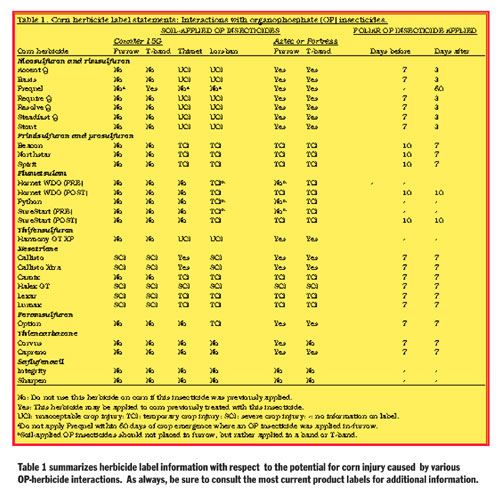Corn Herbicide And Insecticide Precautions
URBANA, ILL.
The commercialization of
corn hybrids with “builtin”
resistance to certain
insect pests has greatly contributed
to the decline in use
of soil insecticides. Some
farmers, however, are considering
applying a soil insecticide
at planting for control of
“other” insect pests or for control/suppression
of certain corn nematodes. Many insecticide
choices are available to farmers, but several
could restrict the use of certain corn herbicides.
Specifically, using an organophosphate (OP) insecticide
at planting or after corn emergence
could restrict the use of herbicides that inhibit
either the ALS or HPPD enzymes. The precautions
and restrictions most often appear on the
herbicide label and are due to the increased potential
for corn injury following use of OP insecticides
and ALS- or HPPD-inhibiting herbicides.
Why do certain combinations of OP insecticides
and ALS- or HPPD-inhibiting herbicides
cause injury to corn? Most of these herbicides
are systemic, meaning they move extensively
(translocate) from their site of uptake. Translocated
compounds often accumulate in areas of
the plant undergoing active cell division (meristems).
Both insecticides and herbicides are
compounds foreign to the corn plant. The plant
tries to defend itself against any potential injury
a foreign compound could cause by rendering it
inert, or nonphytotoxic. This process is commonly
referred to as metabolism, or breakdown,
of foreign compounds. A corn plant uses several
different pathways to detoxify foreign compounds,
but the OP insecticides and many ALSand
HPPD-inhibiting herbicides share a common
metabolic pathway. When an insecticide or
herbicide is present within the plant, the plant
can usually metabolize the compound before it
may cause any deleterious effects. However, if
both insecticide and herbicide are present, the
pathway cannot effectively metabolize both
compounds. When this happens, corn injury
can result. Δ
DR. AARON HAGER: Extension
Specialist/Weed Science, University of Illinois
